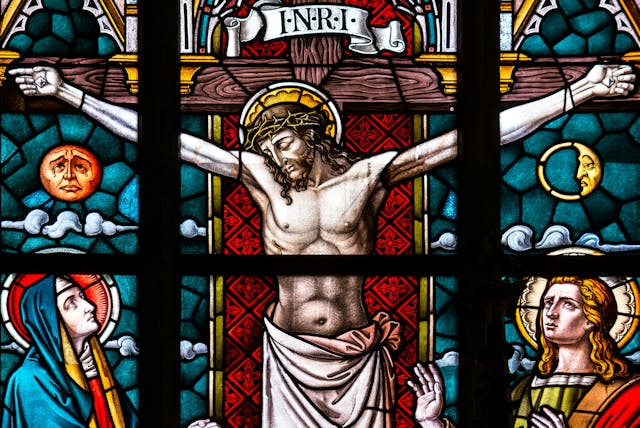(Image obtained here)
Catholicism is the religion of death. It is a morbid religion, with constant thoughts about the end of life in this world. Just look at the central symbolism of the Catholic faith: Jesus wounded and nailed to the cross, with wounds on his hands, feet and side. Deriving from this central image, comes the Way of the Cross (where we contemplate Jesus Carrying his cross), the Sorrowful Mysteries of the Rosary (with prayers and reflections on his death), devotion to the five wounds of Christ, to his Holy Face, among others. The crown of thorns worn by the Messiah is the one crown a Catholic desires. [1].
According to Pope Benedict XVI, Catholicism and the Orthodox Church differed greatly due to a difference in emphasis in the vision regarding Christ: while in the Eastern churches the figure of the resurrected Christ was valued, in the Roman church the figure of the Christ crucified [2]. This subtle difference, over the centuries, led to a great distinction in their theologies.
And the Catholic symbolism of death does not stop with Jesus, since several Catholic saints went through similar experiences: Saint Polycarp, who was burned; Saint Bartholomew, whose skin was flayed; Saint Sebastian, with his half-naked image with arrows on his body; Saint Lucy, holding a tray with her eyes; Saint Denis, carrying his own head; the saints who entered religious life, always with a deep and melancholy look; the countless images of the Mother of God, such as the famous Pietá, in which she holds her dead son; and the photos of more recent saints, such as Saint Padre Pio and Saint Teresa of Calcutta, in which we see the spirit of mortification in their eyes [3].
It is a religion that venerates men and women who were crucified, stoned, eaten by lions, burned, beheaded and every other type of horrible death you can think of. It is the church of the martyrs. It is the religion that chews God. For a Catholic, dying for the faith is the greatest proof that a person truly lived.
For those who are Catholic, living is a preparation for death. It is not just a philosophical, theoretical preparation, in which you theologically reflect on heaven and hell: it is also a physical preparation, where the Christian must mortify his own body with fasting and abstinence, with detachment from material goods, by renouncing certain pleasures in pursuit of a higher calling and, finally, by self-flagellation through instruments such as the cilice [4].
In this sense, the Catholic Church distinguishes itself very sharply from Protestants who, by emphasizing the power of God’s Grace, began to abdicate almost entirely from bodily mortifications – after all, if Christ has already done everything for us, there is nothing left for us but to accept salvation [5]. As an exception, we can mention fasting, since this practice is widely recorded in both the Old and New Testaments.
It is as if a Catholic lives his entire life with the following thought: “This life is just a preparation, a tiny point of my entire existence”. And indeed it is: considering that a human lives for around 80 years, this is nothing compared to eternal life which, as the name suggests, will last forever. And yet, it is in this limited life that the Catholic must purify himself to be able to be with God face to face. “One is life and then judgment”, said Saint Paul. Therefore, it makes sense to give up temporary pleasures in favor of something that will last forever and will be immeasurably better than the earthly experience. As S. Tereza said, “Life is but a night spent in a miserable inn.” [6].
As a result, Catholics come to understand that it is necessary to live in the present moment and do what they can with what they have. “Do what you must and it is in what you do”, says Saint Josemaria [7]. With the experience of religion, the Catholic stops clinging to past mistakes and bad choices – especially because they were what made it possible for him to experience the Christian life at that moment – and stops worrying about that future that he cannot predict, putting things in God’s hands. For the Catholic, the only important times are “now and at the hour of our death”.
It is no surprise that younger generations no longer view Catholicism as the faith of their grandparents, with difficult prayers and unnecessary rites, and are embracing its morbid and dark side, giving rise to a renewed faith.
Additional reading:
[1] A great text that complements the theme of this article can be read in the work In Conversation with God, Francisco Fernández-Carvajal, in the meditation on Friday of the 32nd week of ordinary time.
[2] Benedict XVI, Introduction to the Spirit of the Liturgy (chapter 5)
[3] Volumes VI and VII of the collection In Conversation with God, by Francisco Fernández-Carvajal, has Excellent reflections on several of the Church’s most famous saints.
[4] Several excerpts from the Gospel indicate the need to mortify the body, such as Mark 9, Matthew 6, Luke 9 and John 12.
[5] This discussion is further developed in Catholic Church, Builder of Civilization, by Thomas Woods Jr.
[6] Phrase attributed to Saint Teresa of Avila.
[7] Point 815 of the book The Way, by Saint Josemaria Escriva.
